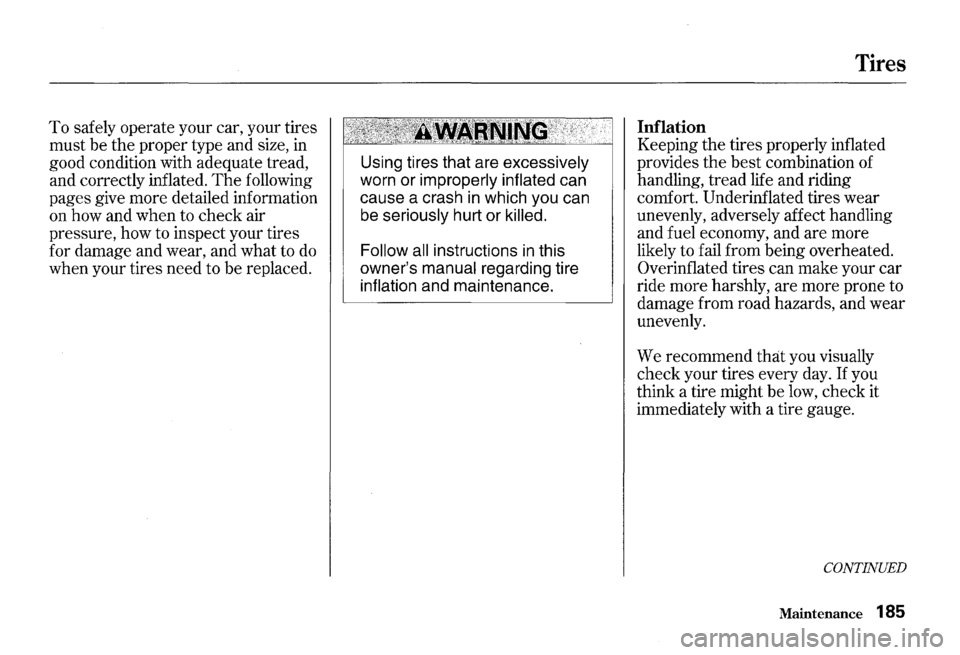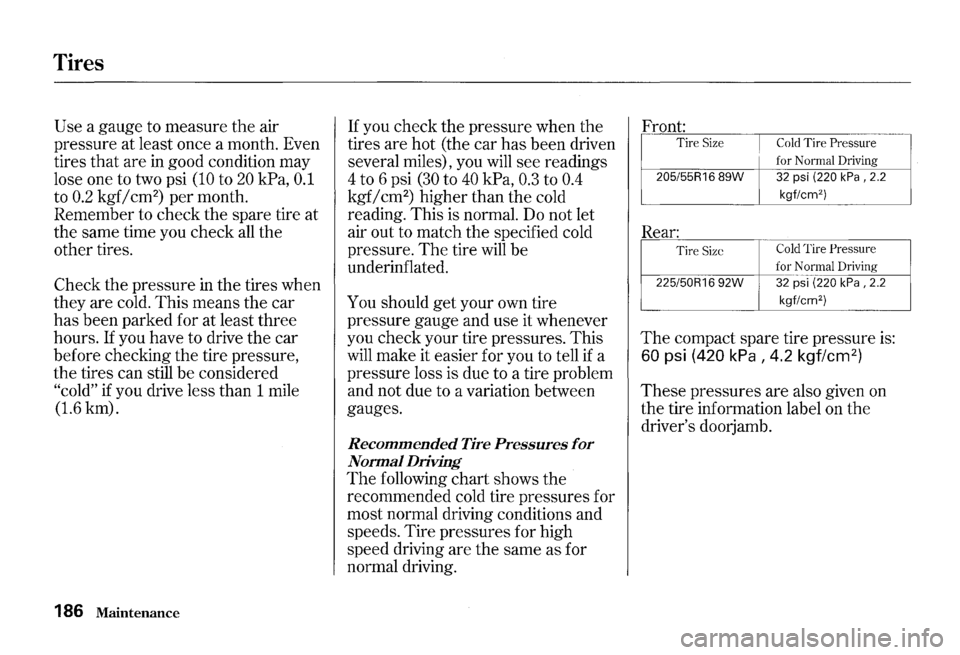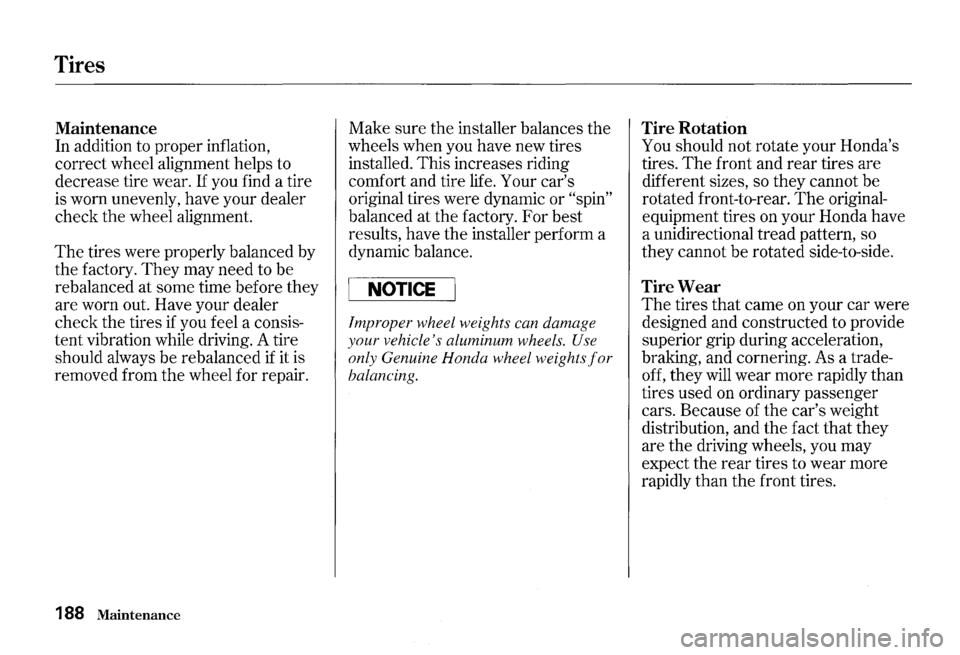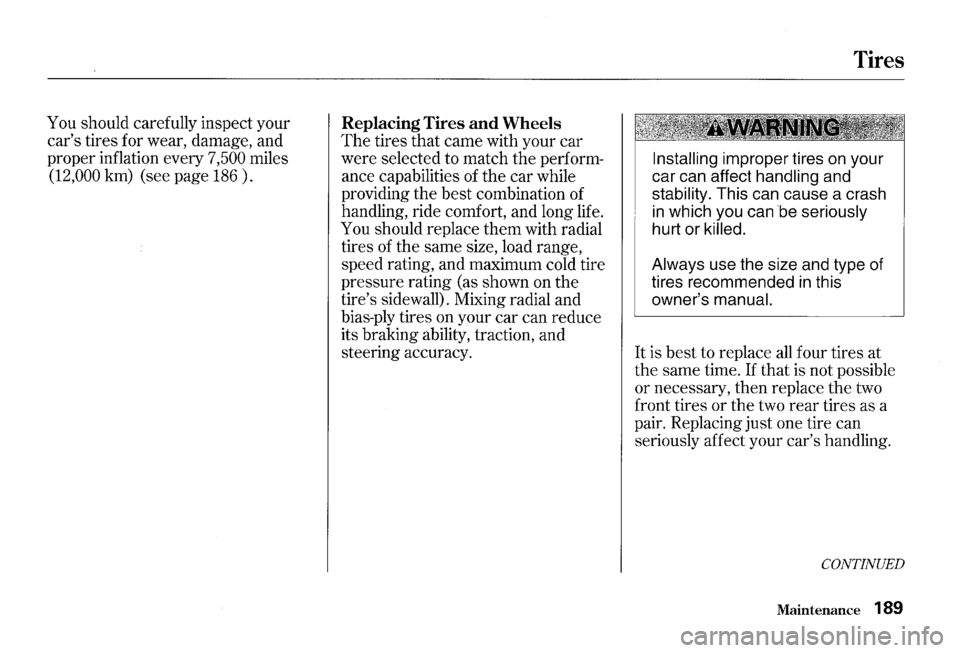Page 158 of 273
You should check the following
items at the specified intervals.
If
you are unsure of how to perform
any check, turn to the page given.
• Engine oil level -Check every
time you
fill the fuel tank. See
page 119.
• Engine coolant level -Check the
radiator reserve tank every time
you
fill the fuel tank. See page 120 .
• Windshield washer fluid -Check
the level in the reservoir monthly.
If weather conditions cause you to
use the washers frequently, check
the reservoir each time you stop
forfuel. See page 167.
• Brakes and clutch -Check the
fluid level monthly. See page
170 .
Owner Maintenance Checks
• Tires -Check the tire pressure
monthly. Examine the tread for
wear and foreign objects. See page
186.
• Lights -Check the operation of
the headlights, parking lights,
taillights, high-mount brake light,
turn signals, brake lights, and
license plate lights monthly. See
page 192.
Maintenance 155
Page 188 of 273

To safely operate your car, your tires
must be
the proper type and size, in
good condition with adequate tread,
and correctly inflated.
The following
pages give more detailed information
on how and when to check air
pressure, how to inspect your tires
for damage and wear, and what to
do
when your tires need to be replaced.
Using tires that are excessively
worn or improperly inflated can
cause a crash
in which you can
be
seriously hurt or killed.
Follow all
instructions in this
owner's
manual regarding tire
inflation and maintenance.
Tires
Inflation
Keeping the tires properly inflated
provides the
best combination of
handling, tread life and riding
comfort. Underinflated tires wear
unevenly, adversely affect handling
and fuel economy, and are more
likely to fail from being overheated.
Overinflated tires can make your car
ride more harshly, are more prone to
damage from road hazards, and wear
unevenly.
We recommend that you visually
check your tires every day.
If you
think a tire might be
low, check it
immediately with a tire gauge.
CONTINUED
Maintenance 185
Page 189 of 273

Tires
Use a gauge to measure the air
pressure at least once a month. Even
tires that are
in good condition may
lose one to two psi
(10 to 20 kPa, 0.1
to 0.2 kgf/ cm2
) per month.
Remember to check the spare tire at
the same
time you check all the
other tires.
Check the pressure in the tires when
they are cold. This means the car
has been parked for at least three
hours. If you have to drive the car
before checking the tire pressure,
the tires can still be considered
"cold" if you drive less than 1 mile
(1.6 km).
186 Maintenance
If you check the pressure when the
tires are hot (the car has been driven
several miles), you
will see readings
4 to 6 psi
(30 to 40 kPa, 0.3 to 0.4
kgf/cm2
) higher than the cold
reading. This is normal. Do not let
air out to match the specified cold
pressure.
The tire will be
underinflated.
You should get your own tire
pressure gauge and use it whenever
you check your tire pressures. This
will make it easier for you to tell if a
pressure loss is due to a tire problem
and not due to a variation between
gauges.
Recommended Tire Pressures for
Normal Driving
The following chart shows the
recommended cold tire pressures for
most normal driving conditions and
speeds. Tire pressures for high
speed driving are
the same as for
normal driving.
Fro=n~t:~~---,--~~---------, Tire Size Cold Tire Pressure
205/55R16 89W
Rear:
Tire Size
225/50R16 92W
for Normal Driving
32 psi (220 kPa , 2.2
kgf/cm2
)
I Cold Tire Pressure
for Normal Driving
! 32 psi (220 kPa , 2.2
L_ ___________ .L.I __ k.=..gf_lc_m_2_) _ --·-·-·-·-·-
The compact spare tire pressure is:
60 psi (420 kPa , 4.2 kgf/cm2
)
These pressures are also given on
the tire information label on the
driver's doorjamb.
Page 190 of 273

Tubeless tires have some ability to
self-seal
if they are punctured.
However, because leakage is often
very slow, you should look closely
for punctures if a tire starts losing
pressure.
Inspection
Every time you check inflation, you
should also examine the tires for
damage, foreign objects, and wear.
You should look for:
• Bumps or bulges in the tread or
side of the tire. Replace the tire
if
you find either of these conditions.
• Cuts, splits, or cracks in the side
of the tire. Replace the tire
if you
can see fabric or cord.
• Excessive tread wear.
Tires
Your car's tires have wear indicators
molded into the tread. When the
tread wears down to that point, you
will see a
1/2 inch (12.7 mm) wide
band running across the tread.
This
shows there is less than 1/16 inch
(1.6 mm) of tread left on the tire. A
tire
that is this worn gives very little
traction on wet roads. You should
replace
the tire if you can see the
tread wear indicator in three or more
places around the tire.
Maintenance 187
Page 191 of 273

Tires
Maintenance
In addition to proper inflation,
correct wheel alignment helps to
decrease tire wear.
If you find a tire
is worn unevenly, have your dealer
check the wheel alignment.
The tires were properly balanced by
the factory.
They may need to be
rebalanced at some time before they
are worn out. Have your dealer
check the tires
if you feel a consis
tent vibration while driving. A tire
should always be rebalanced if it is
removed from
the wheel for repair.
188 Maintenance
Make sure the installer balances the
wheels when you have new tires
installed. This increases riding
comfort and tire life.
Your car's
original tires were dynamic or
"spin"
balanced at the factory. For best
results, have the installer perform a
dynamic balance.
NOTICE
Improper wheel weights can damage
your vehicle's aluminum wheels.
Use
only Genuine Honda wheel weights for
balancing.
Tire Rotation
You should not rotate your Honda's
tires.
The front and rear tires are
different sizes, so they cannot be
rotated front-to-rear.
The original
equipment tires on your Honda have
a unidirectional tread pattern, so
they cannot be rotated side-to-side.
Tire Wear
The tires that came on your car were
designed and constructed to provide
superior grip during acceleration,
braking, and cornering. As a trade
off, they
will wear more rapidly than
tires used on ordinary passenger
cars. Because of the car's weight
distribution, and the fact that they
are the driving wheels, you may
expect the
rear tires to wear more
rapidly than the front tires.
Page 192 of 273

You should carefully inspect your
car's tires for wear, damage, and
proper inflation every
7,500 miles
(12,000 km) (see page 186 ) .
Replacing Tires and Wheels
The tires that came with your car
were selected to match the perform
ance capabilities of the car while
providing the best combination of
handling, ride comfort, and long life.
You should replace them with radial
tires of the same size, load range,
speed rating, and maximum cold tire
pressure rating (as shown on the
tire's sidewall). Mixing radial and
bias-ply tires on your car can reduce
its braking ability, traction, and
steering accuracy.
Tires
Installing improper tires on your
car can affect
handling and
stability. This can cause a crash
in which you can be seriously
hurt or killed.
Always
use the size and type of
tires recommended
in this
owner's
manual.
It is best to replace all four tires at
the same time. If that is not possible
or necessary, then replace the two
front tires or the two
rear tires as a
pair. Replacing just one tire can
seriously affect your car's handling.
CONTINUED
Maintenance 189
Page 193 of 273

Tires
The ABS works by comparing the
speed of the wheels. When replacing
tires, use the same size originally
supplied with the car. Tire size and
construction can affect wheel speed
and may cause the system to work
in
consistently.
If you ever need to replace a wheel,
make sure the wheel's specifications
match those of the original wheel
that came on your car. Replacement
wheels are available at your Honda
dealer.
190 Maintenance
Wheels and Tires
Wheels:
Front:
16x61/2JJ
Rear:
16x71/2JJ
Tires: Front:
205/55R16 89W
Rear:
225/50R16 92W
See page 246 for information about
DOT Tire Quality Grading.
Winter Driving
Tires that are marked "M + S" on the
sidewall have an all-weather tread
design.
They should be suitable for
most winter driving conditions. Tires
without these markings are designed
for optimum traction in dry
conditions.
They may not provide
adequate performance in winter
driving.
For the best performance in snowy
or icy conditions, you should install
snow tires or tire chains.
They may
be required by local laws under
certain conditions.
Page 194 of 273

Snow Tires
If you mount snow tires on your
Honda, make sure they are radial
tires of the same size and load range
as
the original tires. Mount snow
tires on
all four wheels to balance
your vehicle's handling in all weather
conditions. Keep
in mind the traction
provided by snow tires on dry roads
may not be as high as your vehicle's
original equipment tires. You should
drive cautiously even when the roads
are clear. Check with the tire dealer
for maximum speed recommenda
tions.
Tire Chains
Because your Honda has limited tire
clearance, mount only
SAE Class "S"
cable-type traction devices on the
rear tires.
Use traction devices only
when required by driving conditions
or local laws. Make sure they are the
correct size for your tires.
Metal link-type
"chains" should not
be used.
No matter how tight they
seem to be installed, they can come
into contact with the body and
suspension, causing serious damage.
When installing
the cables, follow
the manufacturer's instructions and
mount
them as tightly as you can.
Drive slowly with them installed.
If
you hear them coming in contact
with the body or chassis, stop and
investigate. Make sure the cables are
installed tightly, and
that they are
not contacting the brake lines
or
suspension. Remove them as soon as
you start driving on cleared roads.
Tires
NOTICE
Cables that are the wrong size or
improperly installed can damage your ·
car's brake lines, suspension, body, and
wheels. Stop driving (l they are hitting
any part
of the car.
Maintenance 191